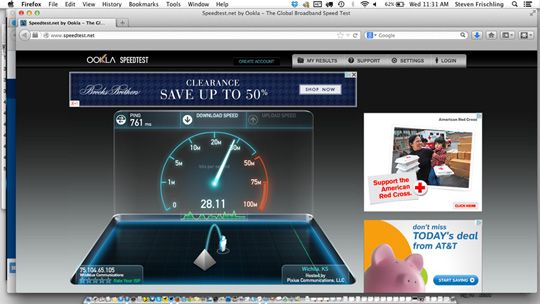Wifi In The Sky … That Is Faster Than Your Living Room
Today launched the official start of Jetblue’s new in-flight wifi service Fly-Fi, which will allow not only allow gate-to-gate wifi service starting in January 2014, but also speeds of 12Mbps from a geosynchronous satellite 22,000 miles up.
As Jetblue flight 9400 boarded aircraft N804JB today for non-stop service from New York’s JFK International Airport to New York’s JFK International Airport, the markings of the new service were plainly seen by the door. The new JetBlue services does not use the standard wifi logo used by most airlines in the United States, but a larger logo of an aircraft flying through a set of wifi signal bars with the “Fly-Fi powered by Exede Internet” logo, a logo that is impossible to miss by passengers as they board the aircraft.
Flight 9400 was not a usual flight, the aircraft with 150 seats carried a mere 44 passengers, many with the same primary goal … use as much bandwidth as possible during the 1-hour 52-minute flight to no where. Passengers, made of up members of the media, respected industry bloggers, industry influencers, spent their time watching streaming media, uploading and downloading large files and conducting video conferences.
Most passengers have grown accustomed to an in-flight wifi experience offering passengers download speeds of generally 1Mbps, speeds to slow for dreaming video, not nearly enough bandwidth for using video chats, and woefully slow for sharing large files. Jetblue’s new in-flight Fly-Fi service, utilizing the Ka-Band satellites, is almost impossibly faster than any in-flight wifi experience passengers have experienced before.
Jetblue’s Fly-Fi internet connectivity offers more bandwidth per user than its competitors offer per aircraft. With three access points placed through out the relatively short 90.25-foot long Airbus A320 cabin signal strength is consistent everywhere on board the aircraft, allowing for a users to sit anywhere on board and pull down significant data.
During a test of the service on board Flight 9400 speeds of more than 28Mbps were attainable, with most users consistently exceeding the advertised 12Mpbs speeds, with more than 70 devices being used simultaneously.
While Jetblue is advertising ViaSat’s Fly-Fi service as “At Home in The Sky,” personally, I wish my connectivity speeds at home were this fast and reliable. Having now experienced Fly-Fi, I’d prefer to have “In-Flight In My Livingroom.”
Jetblue’s Fly-Fi service will be free for the next six months, or $9 per hour for those seeking increased data speeds, as the airline installs the hardware into its fleet of aircraft.
Below are a few photos from the flight.
Happy Flying!
The Jetblue Fly-Fi Logo
Aviation journalist Jason Rabinowitz checks out the speed of Fly-Fi on board Jetblue Flight 9400
Routehappy’s John Walton video chats with a colleague on board Jetblue’s Flight 9400
My internet connection speed on board Jetblue’s Flight 9400 using ViaSat’s Fly-Fi





